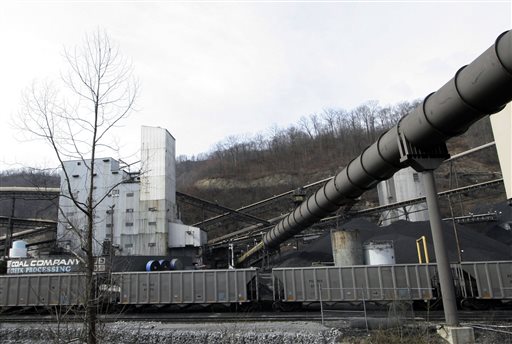The future is here: Climate change, coal and the search for a path forward for the coalfields
August 5, 2015 by Ken Ward Jr.
This Feb. 10, 2006 file photo shows the Sidney Coal Company’s Coal Preparation Plant in Sidney, Ky. (AP Photo/Brian Tietz, File)
It is not surprising that the usual suspects among the West Virginia media have come out in full force to thunder against the final version of the Obama administration’s Clean Power Plan (see here, here and here).
There’s a lot of uninformed talk about “power grabs” and “doctrinaire” regulatory moves, given the near-unlimited flexibility that EPA gives states to come up with their own compliance plans. The Wheeling paper is fixated on why Hawaii was exempt, and Hoppy Kercheval is so eager for some “civil disobedience” that I picture him chaining himself to a computer in Washington in a patriotic attempt to keep the rule from being published in the Federal Register.
The Daily Mail editorial page is ranting about how the EPA rule is “aimed at dramatically reducing use of fossil fuels and forcing rapid shifts toward alternative energy sources like solar and wind.” They ignore the fact that these shifts have already happened, and are continuing to happen, largely as a result of the kinds of market forces that they so love to champion. As we reported today, citing EPA’s analysis of its rule:

We expect that the main impact of this rule on the nation’s mix of generation will be to reduce coal-fired generation, but in an amount and by a rate that is consistent with recent historical declines in coal-fired generation. Specifically, from approximately 2005 to 2014, coal-fired generation declined at a rate that was greater than the rate of reduced coal-fired generation that we expect to result from this rulemaking from 2015 to 2030. In addition, under this rule, the trends for all other types of generation, including natural gas-fired generation, nuclear generation, and renewable generation, will remain generally consistent with what their trends would be in the absence of this rule.
Sadly, the other trend that’s already happening is climate change. As President Obama explained in his remarks at the White House on Monday:
Climate change is no longer just about the future that we’re predicting for our children or our grandchildren; it’s about the reality that we’re living with every day, right now.
The Pentagon says that climate change poses immediate risks to our national security. While we can’t say any single weather event is entirely caused by climate change, we’ve seen stronger storms, deeper droughts, longer wildfire seasons. Charleston and Miami now flood at high tide. Shrinking ice caps forced National Geographic to make the biggest change in its atlas since the Soviet Union broke apart.
The president offered a strong response to those in West Virginia and other coalfield communities — especially our political leaders — who seem to be able to do little more than shake their fist, deny science, and insist that nothing ever change in our world:

They’ll claim this plan is a “war on coal,” to scare up votes — even as they ignore my plan to actually invest in revitalizing coal country, and supporting health care and retirement for coal miners and their families, and retraining those workers for better-paying jobs and healthier jobs. Communities across America have been losing coal jobs for decades. I want to work with Congress to help them, not to use them as a political football. Partisan press releases aren’t going to help those families.
It’s true that the final Clean Power Plan requires deeper cuts in carbon dioxide in West Virginia and other coal states than the draft plan, a fact that Politico’s Michael Grunwald picked up on:
The original draft took it easiest on states with the heaviest reliance on dirty fossil fuels—states that nevertheless complained the most about Obama’s supposedly draconian plan. The final rule cracks down much harder on those states, while taking it much easier on states that are already moving toward cleaner sources of electricity.
That is a radical change. The EPA acknowledged in the plan that it “rectifies what would have been an inefficient, unintended outcome of putting the greater reduction burden on lower-emitting sources and states.”
But it hasn’t gotten attention, perhaps because coal-state politicians cried wolf so loudly about the draft. It’s the result of a decision to calculate emissions according to a uniform measurement for every power plant rather than a weirdly calibrated analysis of what’s reasonable for individual states.
But whether or not the new approach is more technically or legally defensible, getting tougher on dirtier states could have a dramatic effect on results, because states like Kentucky and West Virginia were always unlikely to do any more than the legal minimum, while states like California and Massachusetts are unlikely to stop their transitions to cleaner energy once they achieve compliance.
The drive to cleaner energy is creating jobs. It’s just not, generally speaking, creating them in the coalfields. But that’s largely because the power structure here has been so intent on fighting Obama and EPA that it hasn’t prepared our state well to take advantage of the changing energy markets.
Jason Walsh, a White House official who has been promoting Obama’s $5 billion aid package for coal communities, has argued that local leaders in places like West Virginia can continue the debate all they want about what’s driving coal’s decline, but can at the same time embrace programs that would help their communities, even if coal weren’t in decline. The only thing that makes this not so is that the career political consultants are ready and willing to pounce on any move by any elected official or candidate that isn’t marching to the appropriate “war on coal” tune, which allows for no compromise or cooperation on anything except fighting EPA.
James Van Nostrand, a West Virginia University law professor who has been studying these issues closely, told me yesterday how pleased he is that Gov. Earl Ray Tomblin has not yet signed onto the boycott of the Clean Power Plan that some state and national Republican leaders (joined by Hoppy) are pushing. Still, it’s not like Gov. Tomblin talks much about clean energy or expresses any serious concerns about climate change, or spends much time trying to make West Virginians focus on the urgent need to increase the work on diversifying our coalfield communities. While the governor’s statement after Monday’s release of the final EPA rule may have been more measured than what we saw from, say, Rep. David McKinley, it was hardly inspiring:
After an initial review, it appears the Environmental Protection Agency has made some changes to the proposed Clean Power Plan rule; however, those limited changes still leave us with proposed regulations that are unreasonable, unrealistic and ultimately unattainable for our state. While those who employ our hardworking miners have urged us to refuse to submit a compliance plan, at this point West Virginia still has not determined whether it will submit any plan to the EPA.
“As required by House Bill 2004 passed by the Legislature this year, our Department of Environmental Protection will develop a detailed report for the Legislature that includes ‘a comprehensive analysis of the effect of the Section 111(d) rule on the state.’ In accordance with the new law this analysis, which could not begin until the EPA released its final rule, will be completed within 180 days.
“While the DEP works on the report required by the Legislature, we continue to review our legal options and are working to determine what a federally developed state implementation plan would involve. I appreciate the ongoing work of DEP Secretary Randy Huffman and his staff, who like me, are committed to putting the interests of West Virginians first.”
Gov. Tomblin is up against a pretty low bar, though, given statements like this from Senate President Bill Cole and House Speaker Tim Armstead, both Republicans:
“The release of President Obama’s Clean Power Plan today is sadly something that we have anticipated for years,” Senate President Cole said. “That’s why we took bold, decisive steps in passing House Bill 2004, which provides an additional layer of protection against the relentless attacks on West Virginia’s coal fields. The Legislature absolutely will not approve any State Implementation Plan that will cause more harm, and bring more job losses, to our state’s coal industry.”
Speaker Armstead echoed that commitment.
“The Obama Administration’s Clean Power Plan is another blow to hard working West Virginians who rely on coal-fired power plants for their jobs and livelihood. President Obama, when he was running for President, pledged that if companies continued to rely on coal-fired energy it would bankrupt them. This plan is the latest step in the Obama administration’s pledge to bankrupt the coal industry,” Speaker Armstead said. “Sadly, on the very day that the Obama administration released another round of over-reaching regulations that will further harm our vital coal industry, one of West Virginia’s leading coal producers announced that it had filed for bankruptcy protection.”
“Under the EPA’s new plan, West Virginia, along with other energy producing states, is directed to develop a plan that will impose self-inflicted damage on our state’s struggling economy,” Armstead continued. “All leaders of our state will need to carefully consider whether West Virginia should submit a State Implementation Plan as required by the Clean Power Plan or instead take other steps to fight this latest round of federal overreach.”
Senate Minority Leader (and gubernatorial candidate) did tweet that, if he were governor, his administration would implement the Clean Power Plan “in a flexible way,” resume work on Kessler’s economic diversification program for the southern coalfields and “adopt polities to promote economic growth” in the state’s energy portfolio.
Still, sometimes it may seem a bit tiresome to just keep going back to the words of the late Sen. Robert C. Byrd, but it’s hard to find a West Virginia leader now who will talk any sense at all about these issues:
The greatest threats to the future of coal do not come from possible constraints on mountaintop removal mining or other environmental regulations, but rather from rigid mindsets, depleting coal reserves, and the declining demand for coal as more power plants begin shifting to biomass and natural gas as a way to reduce emissions.
Change has been a constant throughout the history of our coal industry. West Virginians can choose to anticipate change and adapt to it, or resist and be overrun by it. One thing is clear. The time has arrived for the people of the Mountain State to think long and hard about which course they want to choose.

 Subscribe to the Coal Tattoo
Subscribe to the Coal Tattoo
